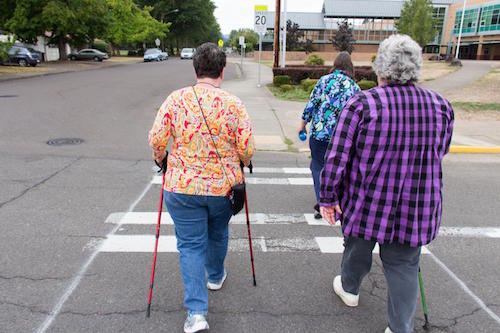
Quality and affordability remain the most important attributes of an assisted living community to prospective residents and their families, but a community’s location in a walkable neighborhood holds stronger appeal than one might expect, according to newly released research from A Place for Mom. And that appeal is expected to grow.
The referral service’s Senior Living Preferences Survey found that quality was the top priority for 68% of those looking for an assisted living community, and affordability was the most important factor to 30%. A community’s neighborhood was the top priority for only 2% of potential residents and their families.
When asked about neighborhood attributes, having a low crime rate (74%), being close to family (60%) and being close to hospitals (58%) were rated as “very important” or “must-have” features.
But those desires are to be expected, A Place for Mom data scientist Ben Hanowell told McKnight’s Senior Living. The email survey — which had responses from 1,246 shoppers for private-pay senior apartments and independent living as well as those seeking assisted living communities — in part aimed to learn more about the walkability preferences of older adults, a population often neglected in discussions about walkability, he said.
“I had a hunch that more senior living consumers than you might think find walkability to be very important to their purchase decision,” Hanowell said. “What I did not expect was that a quarter of assisted living consumers, many of whom have mobility issues, find being within walking distance to some neighborhood amenity, like grocery stores or restaurants, to be very important or mandatory.”
That’s right. When asked about neighborhood features that were important to them, 26% of respondents seeking assisted living communities said that having a walkable neighborhood was “very important” to them or a “must-have” feature, and an additional 66% said it was “somewhat important.” Safety and proximity to public transportation also were important, respondents said.
Of potential residents who said walkability was “very important” or a “must-have,” the characteristic was most important to those who said their monthly budget was less than $2,000 (53%), but close behind were those whose monthly budgets were reported as $5,000 or more (46%). Walkability was “very important” or a “must-have” feature to 33% of those whose budgets ranged from $2,000 to $4,999.
The percentages changed when family members were looking for a community on behalf of a loved one, but those with the lowest budgets still found walkability most appealing, with those who had the highest budgets not far behind.
“Consumers looking for themselves may also prefer walkability more, likely because they are on average six to nine years younger, but maybe also because family members underestimate older relatives’ preferences,” according to the report.
With consumers remaining active longer and younger adults preferring walkable neighborhoods, A Place for Mom predicts that the desire for the characteristic in senior living communities only will increase.
“It’s a trend that should be top-of-mind among developers,” said Charlie Severn, head of marketing at A Place for Mom.
What about existing communities that aren’t located near amenities?
They could become active in local discussions related to urban planning, Hanowell suggested.
“While you’re doing that, get some of your residents involved so you can understand the type of neighborhood where they want to live, the type of neighborhood that would improve retention,” he said.
Being involved in transportation-planning discussions is important, too, Hanowell added.
“I don’t think it’s so much that it’s public transportation or private transportation offered by the community itself,” he said. “I think it’s more about autonomy — going where you want, when you want, despite the fact that you may have some mobility issues.”
Toward that end, ride-hailing services (such as Lyft and Uber), used in a traditional way or via a platform designed for those who don’t use smartphones, might offer a solution to help residents feel more satisfied and independent, Hanowell said.
“Remember that walkability doesn’t necessarily mean ‘urban.’ Just because you’re not in the middle of a city doesn’t mean that your neighborhood isn’t walkable,” he said. “What we’re really talking about is, is there a diversity of services — restaurants, coffee shops, retail shopping, libraries, public parks — around your community? And that could be true in the heart of Manhattan and it also could be true in Auburn, WA, which is a suburb of Seattle.”
In fact, Hanowell said, senior living communities in suburban areas may have an advantage.
“There’s a lot of research out there … [that] suburbs are the fastest-growing areas in our nation,” he said. “And as these suburbs grow, people from multiple generations are going to be flocking to them.”



